Performances of Sheet-Pipe Typed Subsurface Drainage on Land and Water Productivity of Paddy Fields in Indonesia
Abstract
1. Introduction
2. Materials and Methods
3. Results
3.1. Weathers Parameters and Their Conditions
3.2. Water Balance in Both Fields
3.3. Water Productivity and Water Use Efficiency
4. Discussion
5. Conclusions
Author Contributions
Funding
Data Availability Statement
Acknowledgments
Conflicts of Interest
References
- Antonopoulos, V.Z. Modelling of Water and Nitrogen Balances in the Ponded Water and Soil Profile of Rice Fields in Northern Greece. Agric. Water Manag. 2010, 98, 321–330. [Google Scholar] [CrossRef]
- Arif, C.; Toriyama, K.; Nugroho, B.D.A.; Mizoguchi, M. Crop Coefficient and Water Productivity in Conventional and System of Rice Intensification (SRI) Irrigation Regimes of Terrace Rice Fields in Indonesia. J. Teknol. (Sci. Eng.) 2015, 75, 97–102. [Google Scholar] [CrossRef]
- Zhao, L.; Wu, L.; Wu, M.; Li, Y. Nutrient Uptake and Water Use Efficiency as Affected by Modified Rice Cultivation Methods with Reduced Irrigation. Paddy Water Environ. 2011, 9, 25–32. [Google Scholar] [CrossRef]
- Zhao, L.; Wu, L.; Li, Y.; Animesh, S.; Zhu, D.; Uphoff, N. Comparisons of Yield, Water Use Efficiency, and Soil Microbial Biomass as Affected by the System of Rice Intensification. Commun. Soil Sci. Plant Anal. 2010, 41, 1–12. [Google Scholar] [CrossRef]
- Uphoff, N.; Kassam, A.; Harwood, R. SRI as a Methodology for Raising Crop and Water Productivity: Productive Adaptations in Rice Agronomy and Irrigation Water Management. Paddy Water Environ. 2011, 9, 3–11. [Google Scholar] [CrossRef]
- Stoop, W.A. The Scientific Case for System of Rice Intensification and Its Relevance for Sustainable Crop Intensification. Int. J. Agric. Sustain. 2011, 9, 443–455. [Google Scholar] [CrossRef]
- Thakur, A.K.; Mohanty, R.K.; Patil, D.U.; Kumar, A. Impact of Water Management on Yield and Water Productivity with System of Rice Intensification (SRI) and Conventional Transplanting System in Rice. Paddy Water Environ. 2014, 12, 413–424. [Google Scholar] [CrossRef]
- Riza, I.A.; Alkasuma, A. Argicultural Land Tidal Swamp and Development Strategy Era of Regional Autonomy. J. Sumberd. Lahan 2012. [Google Scholar] [CrossRef]
- Nursyamsi, D.; Noor, M.; Maftu’ah, E. Peatland Management for Sustainable Agriculture. In Tropical Peatland Ecosystems; Osaki, M., Tsuji, N., Eds.; Springer: Japan, Tokyo, 2016; pp. 493–511. [Google Scholar] [CrossRef]
- Patil, M.D.; Das, B.S.; Bhadoria, P.B.S. A Simple Bund Plugging Technique for Improving Water Productivity in Wetland Rice. Soil Tillage Res. 2011, 112, 66–75. [Google Scholar] [CrossRef]
- Van der Hoek, W.; Sakthivadivel, R.; Renshaw, M.; Silver, J.; Birley, M.; Konradsen, F. Alternate Wet/Dry Irrigation in Rice Cultivation: A Practical Way to Save Water and Control Malaria and Japanese Encephalitis? Research Report 47; IWMI: Colombo, Sri Lanka, 2001. [Google Scholar]
- Molden, D.; Oweis, T.; Steduto, P.; Bindraban, P.; Hanjra, M.A.; Kijne, J. Improving Agricultural Water Productivity: Between Optimism and Caution. Agric. Water Manag. 2010, 97, 528–535. [Google Scholar] [CrossRef]
- Ayars, J.E.; Evans, R.G. Subsurface Drainage—What’s Next? Irrig. Drain. 2015, 64, 378–392. [Google Scholar] [CrossRef]
- Kumar, R.; Bhakar, S.R.; Singh, P.K. Evaluation of Hydraulics Characteristics and Management Strategies of Subsurface Drainage System in Indira Gandhi Canal Command. Agric. Eng. Int. CIGR J. 2013, 15, 1–9. [Google Scholar]
- Darzi-Naftchali, A.; Shahnazari, A. Influence of Subsurface Drainage on the Productivity of Poorly Drained Paddy Fields. Eur. J. Agron. 2014, 56, 1–8. [Google Scholar] [CrossRef]
- Chan, C.S.; Cheong, A.W. Subsurface Drainage Effect on Soil and Rice Crop. J. Trop. Agric. Food Sci. 2001, 29, 177–188. [Google Scholar]
- Jung, K.Y.; Yun, E.S.; Park, K.D.; Lee, Y.H.; Hwang, J.B.; Park, C.Y.; Ramos, E.P. Effect of Subsurface Drainage for Multiple Land Use in Sloping Paddy Fields. In Proceedings of the 19th World Congress of Soil Science, Soil Solutions for a Changing World, Brisbane, Australia, 1–6 August 2010; pp. 1–6. [Google Scholar]
- Mathew, E.K.; Panda, R.K.; Nair, M. Influence of Subsurface Drainage on Crop Production and Soil Quality in a Low-Lying Acid Sulphate Soil. Agric. Water Manag. 2001, 47, 191–209. [Google Scholar] [CrossRef]
- Ritzema, H.P.; Satyanarayana, T.V.; Raman, S.; Boonstra, J. Subsurface Drainage to Combat Waterlogging and Salinity in Irrigated Lands in India: Lessons Learned in Farmers’ Fields. Agric. Water Manag. 2008, 95, 179–189. [Google Scholar] [CrossRef]
- Shiratori, Y.; Watanabe, H.; Furukawa, Y.; Tsuruta, H.; Inubushi, K. Effectiveness of a Subsurface Drainage System in Poorly Drained Paddy Fields on Reduction of Methane Emissions. Soil Sci. Plant Nutr. 2007, 53, 387–400. [Google Scholar] [CrossRef]
- Furukawa, Y.; Shiratori, Y.; Inubushi, K. Depression of Methane Production Potential in Paddy Soils by Subsurface Drainage Systems. Soil Sci. Plant Nutr. 2008, 54, 950–959. [Google Scholar] [CrossRef]
- Darzi-Naftchali, A.; Mirlatifi, S.M.; Shahnazari, A.; Ejlali, F.; Mahdian, M.H. Effect of Subsurface Drainage on Water Balance and Water Table in Poorly Drained Paddy Fields. Agric. Water Manag. 2013, 130, 61–68. [Google Scholar] [CrossRef]
- Darzi-Naftchali, A.; Ritzema, H.; Karandish, F.; Mokhtassi-Bidgoli, A.; Ghasemi-Nasr, M. Alternate Wetting and Drying for Different Subsurface Drainage Systems to Improve Paddy Yield and Water Productivity in Iran. Agric. Water Manag. 2017, 193, 221–231. [Google Scholar] [CrossRef]
- Feng, G.; Zhang, Z.; Wan, C.; Lu, P.; Bakour, A. Effects of Saline Water Irrigation on Soil Salinity and Yield of Summer Maize (Zea mays L.) in Subsurface Drainage System. Agric. Water Manag. 2017, 193, 205–213. [Google Scholar] [CrossRef]
- Setiawan, B.; Saptomo, S.; Arif, C.; Sulaiman, A.; Herodian, S.; Matsuda, H.; Tamura, K.; Inoue, Y. Waterflow in the Paddy Field Installed with Sheetpipe Mole Drains. IOP Conf. Ser. Earth Environ. Sci. 2019, 355, 12077. [Google Scholar] [CrossRef]
- Wu, I.P. A Simple Evapotranspiration Model for Hawaii: The Hargreaves Model; CTAHR Fact Sheet Engeineer’s Notebook 106; University of Hawaii: Manoa, HI, USA, 1997. [Google Scholar]
- Hargreaves, G.H.; Allen, R.G. History and Evaluation of Hargreaves Evapotranspiration Equation. J. Irrig. Drain. Eng. 2003, 129, 53–63. [Google Scholar] [CrossRef]
- Arif, C.; Setiawan, B.I.; Mizoguchi, M.; Doi, R. Estimation of Water Balance Components in Paddy Fields under Non-Flooded Irrigation Regimes by using Excel Solver—SciAlert Responsive Version. J. Agron. 2012, 11, 53–59. [Google Scholar] [CrossRef]
- Arif, C.; Setiawan, B.I.; Sofiyuddin, H.A.; Martief, L.M.; Mizoguchi, M.; Doi, R. Estimating Crop Coefficient in Intermittent Irrigation Paddy Fields Using Excel Solver. Rice Sci. 2012, 19, 143–152. [Google Scholar] [CrossRef]
- Allen, R.; Pareira, L.; Raes, D.; Smith, M. FAO Irrigation and Drainage Paper No. 56. Crop Evapotranspiration (Guidelines for Computing Crop Water Requirements); Food and Agriculture Organisation of the United Nations: Rome, Italy, 1998. [Google Scholar]
- Tyagi, N.K.; Sharma, D.K.; Luthra, S.K. Determination of Evapotranspiration and Crop Coefficients of Rice and Sunflower with Lysimeter. Agric. Water Manag. 2000, 45, 41–54. [Google Scholar] [CrossRef]
- Vu, S.H.; Watanabe, H.; Takagi, K. Application of FAO-56 for Evaluating Evapotranspiration in Simulation of Pollutant Runoff from Paddy Rice Field in Japan. Agric. Water Manag. 2005, 76, 195–210. [Google Scholar] [CrossRef]
- Bouman, B.A.M.; Peng, S.; Castañeda, A.R.; Visperas, R.M. Yield and Water Use of Irrigated Tropical Aerobic Rice Systems. Agric. Water Manag. 2005, 74, 87–105. [Google Scholar] [CrossRef]
- Arif, C.; Setiawan, B.I.; Sofiyuddin, H.A.; Martief, L.M. Enhanced Water Use Efficiency by Intermittent Irrigation for Irrigated Rice in Indonesia. J. Islamic Perspect. Sci. Technol. Soc. 2013, 1, 12–17. [Google Scholar]
- Kalita, P.K.; Kanwar, R.S.; Rahman, M.A. Modeling percolation losses from a ponded field under variable water-table conditions. J. Am. Water Resour. Assoc. 1992, 28, 1023–1036. [Google Scholar] [CrossRef]
- Guerra, L.C.; Bhuiyan, S.I.; Tuong, T.P.; Barker, R. Producing More Rice with Less Water from Irrigated Systems; International Irrigation Management Institute: Colombo, Sri Lanka, 1998. [Google Scholar]
- Tuong, T.P.; Bhuiyan, S.I. Increasing Water-Use Efficiency in Rice Production: Farm-Level Perspectives. Agric. Water Manag. 1999, 40, 117–122. [Google Scholar] [CrossRef]
- Lin, X.; Zhu, D.; Lin, X. Effects of Water Management and Organic Fertilization with SRI Crop Practices on Hybrid Rice Performance and Rhizosphere Dynamics. Paddy Water Environ. 2011, 9, 33–39. [Google Scholar] [CrossRef]
- Sato, S.; Yamaji, E.; Kuroda, T. Strategies and Engineering Adaptions to Disseminate SRI Methods in Large-Scale Irrigation Systems in Eastern Indonesia. Paddy Water Environ. 2011, 9, 79–88. [Google Scholar] [CrossRef]
- Djaman, K.; Mel, V.C.; Diop, L.; Sow, A.; El-Namaky, R.; Manneh, B.; Saito, K.; Futakuchi, K.; Irmak, S. Effects of Alternate Wetting and Drying Irrigation Regime and Nitrogen Fertilizer on Yield and Nitrogen Use Efficiency of Irrigated Rice in the Sahel. Water 2018, 10, 711. [Google Scholar] [CrossRef]
- Crop Management Techniques to Enhance harvest Index in Rice|Journal of Experimental Botany|Oxford Academic. Available online: https://academic.oup.com/jxb/article/61/12/3177/425540 (accessed on 18 May 2020).
- Kato, Y.; Okami, M.; Katsura, K. Yield Potential and Water Use Efficiency of Aerobic Rice (Oryza sativa L.) in Japan. Field Crop. Res. 2009, 113, 328–334. [Google Scholar] [CrossRef]
- Kato, Y.; Katsura, K. Rice Adaptation to Aerobic Soils: Physiological Considerations and Implications for Agronomy. Plant Prod. Sci. 2014, 17, 1–12. [Google Scholar] [CrossRef]
- Kato, Y.; Okami, M. Root Growth Dynamics and Stomatal Behaviour of Rice (Oryza sativa L.) Grown under Aerobic and Flooded Conditions. Field Crop. Res. 2010, 117, 9–17. [Google Scholar] [CrossRef]
- Kato, Y.; Okami, M. Root Morphology, Hydraulic Conductivity and Plant Water Relations of High-Yielding Rice Grown under Aerobic Conditions. Ann. Bot. 2011, 108, 575–583. [Google Scholar] [CrossRef]
- Alberto, M.C.R.; Wassmann, R.; Hirano, T.; Miyata, A.; Hatano, R.; Kumar, A.; Padre, A.; Amante, M. Comparisons of Energy Balance and Evapotranspiration between Flooded and Aerobic Rice Fields in the Philippines. Agric. Water Manag. 2011, 98, 1417–1430. [Google Scholar] [CrossRef]
- Wahba, M.A.S.; Christen, E.W.; Amer, M.H. Irrigation Water Saving by Management of Existing Subsurface Drainage in Egypt. Irrig. Drain. 2005, 54, 205–215. [Google Scholar] [CrossRef]
- Kadiyala, M.D.M.; Mylavarapu, R.S.; Li, Y.C.; Reddy, G.B.; Reddy, M.D. Impact of Aerobic Rice Cultivation on Growth, Yield, and Water Productivity of Rice–Maize Rotation in Semiarid Tropics. Agron. J. 2012, 104, 1757–1765. [Google Scholar] [CrossRef]

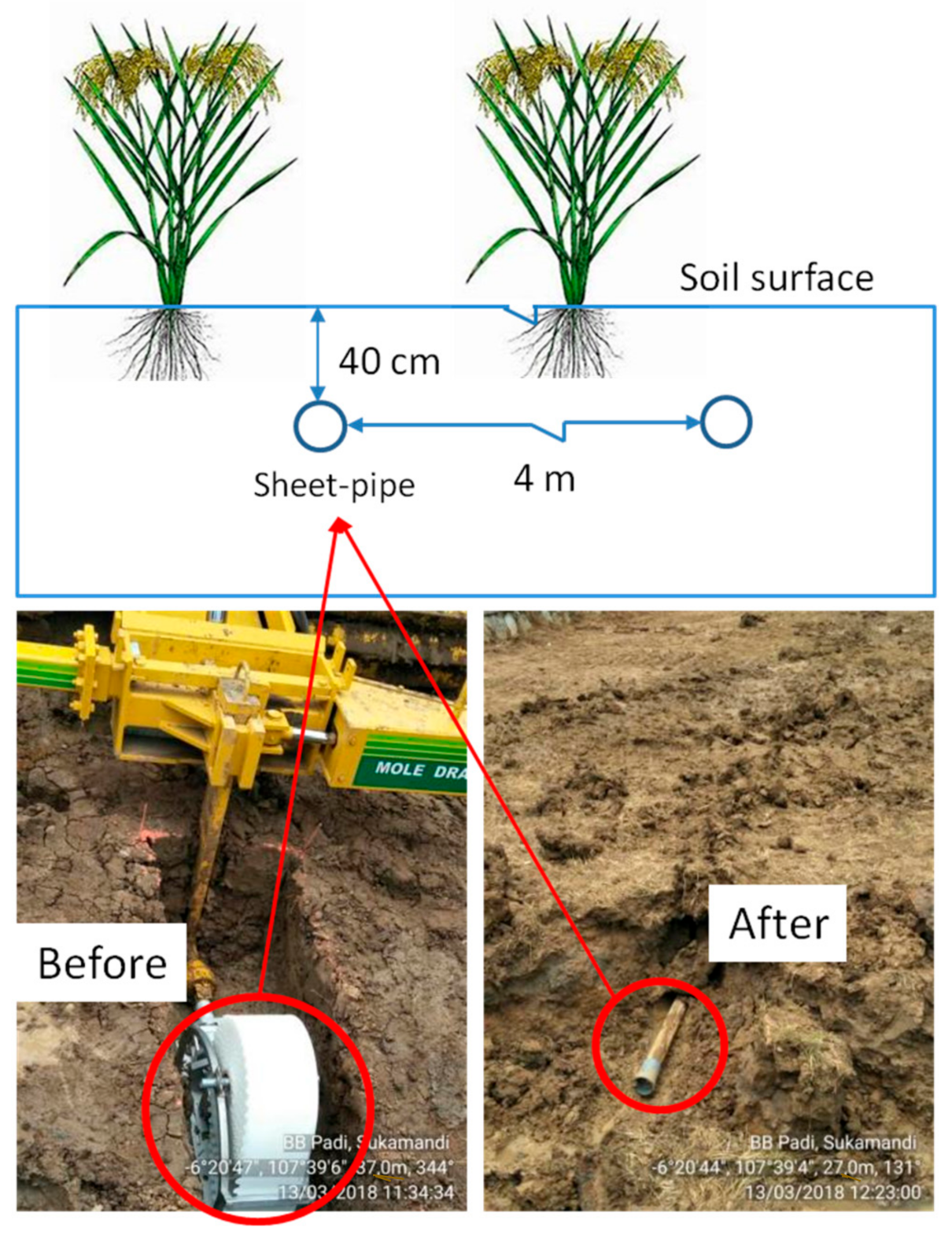
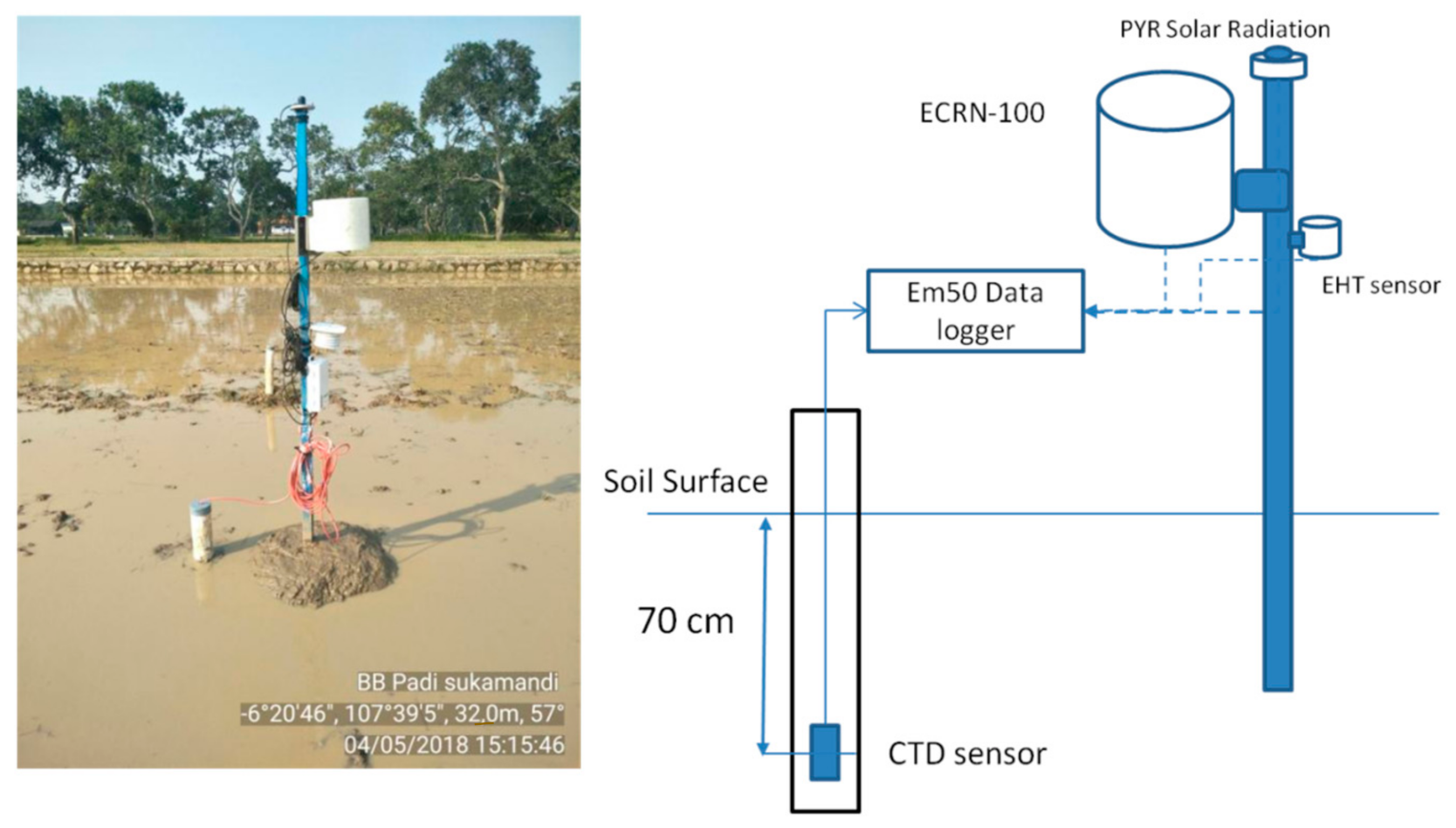
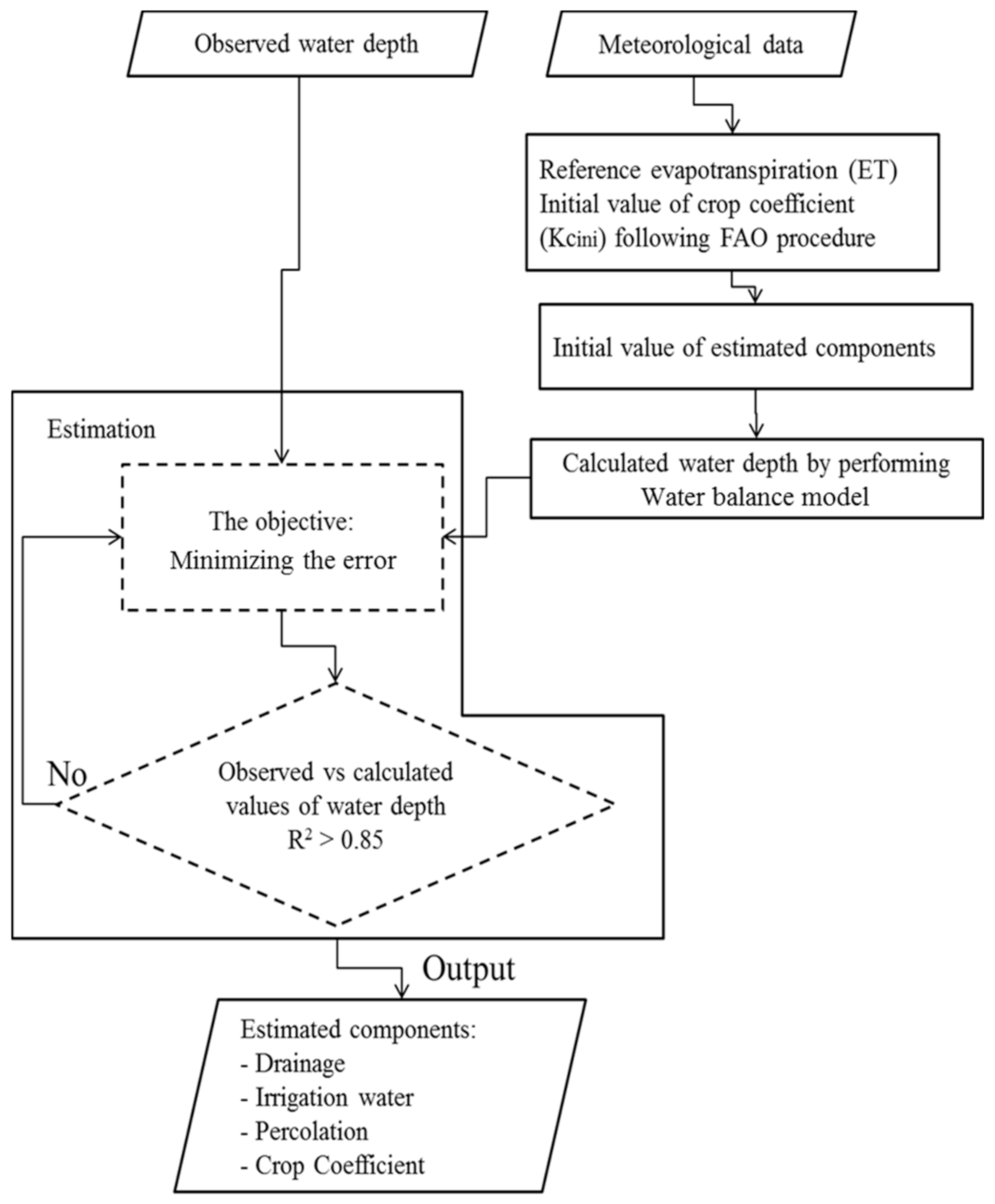
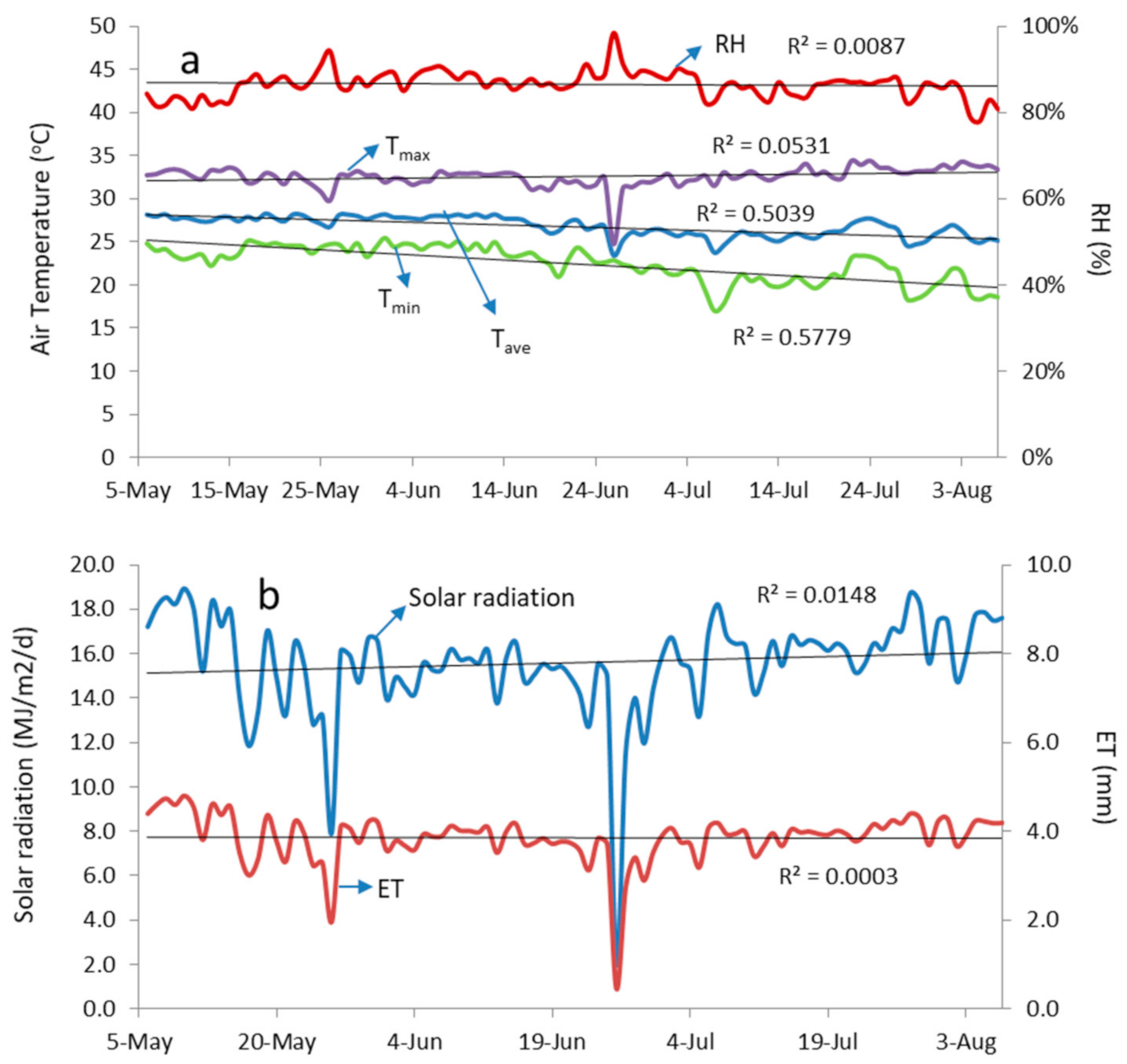
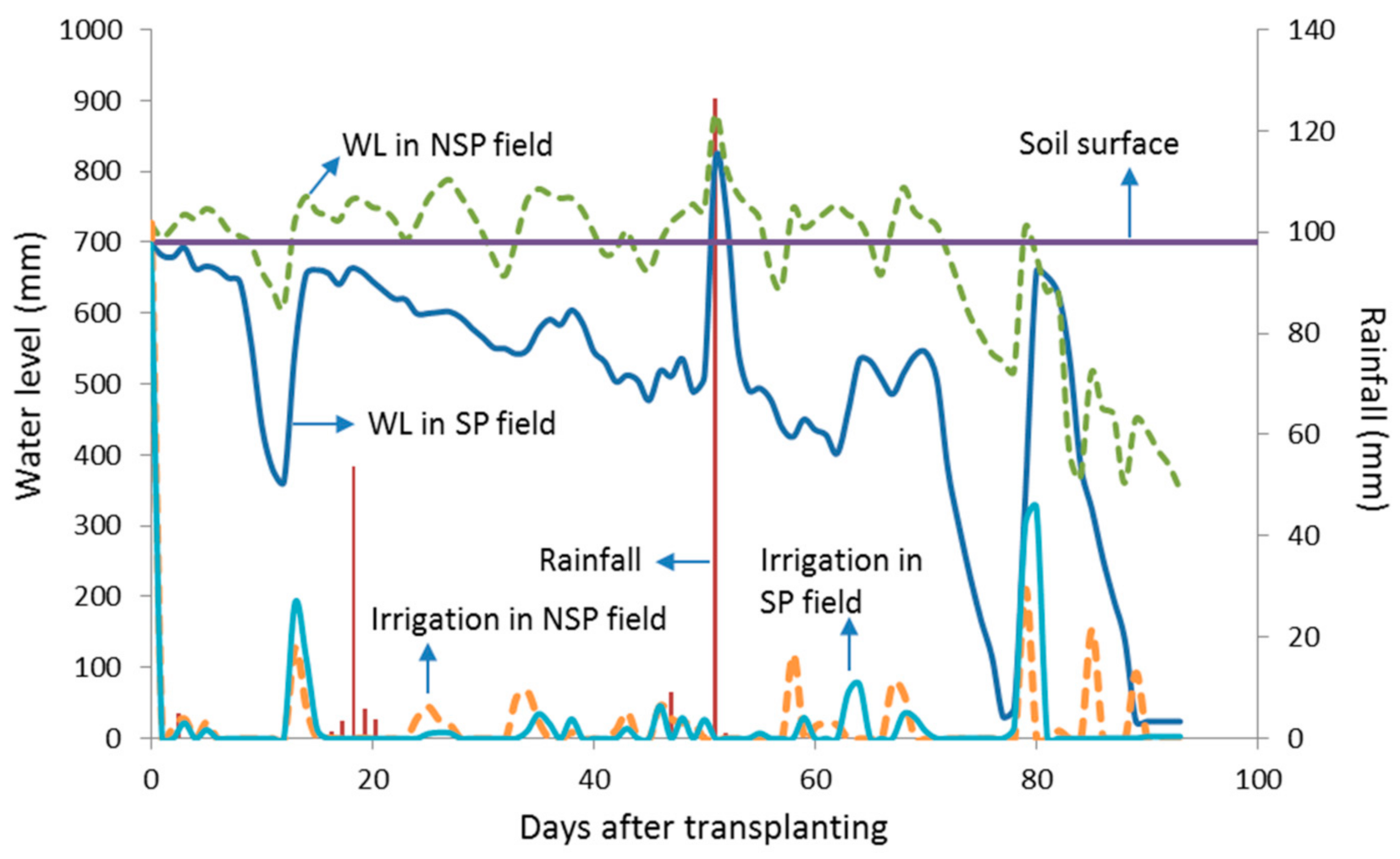
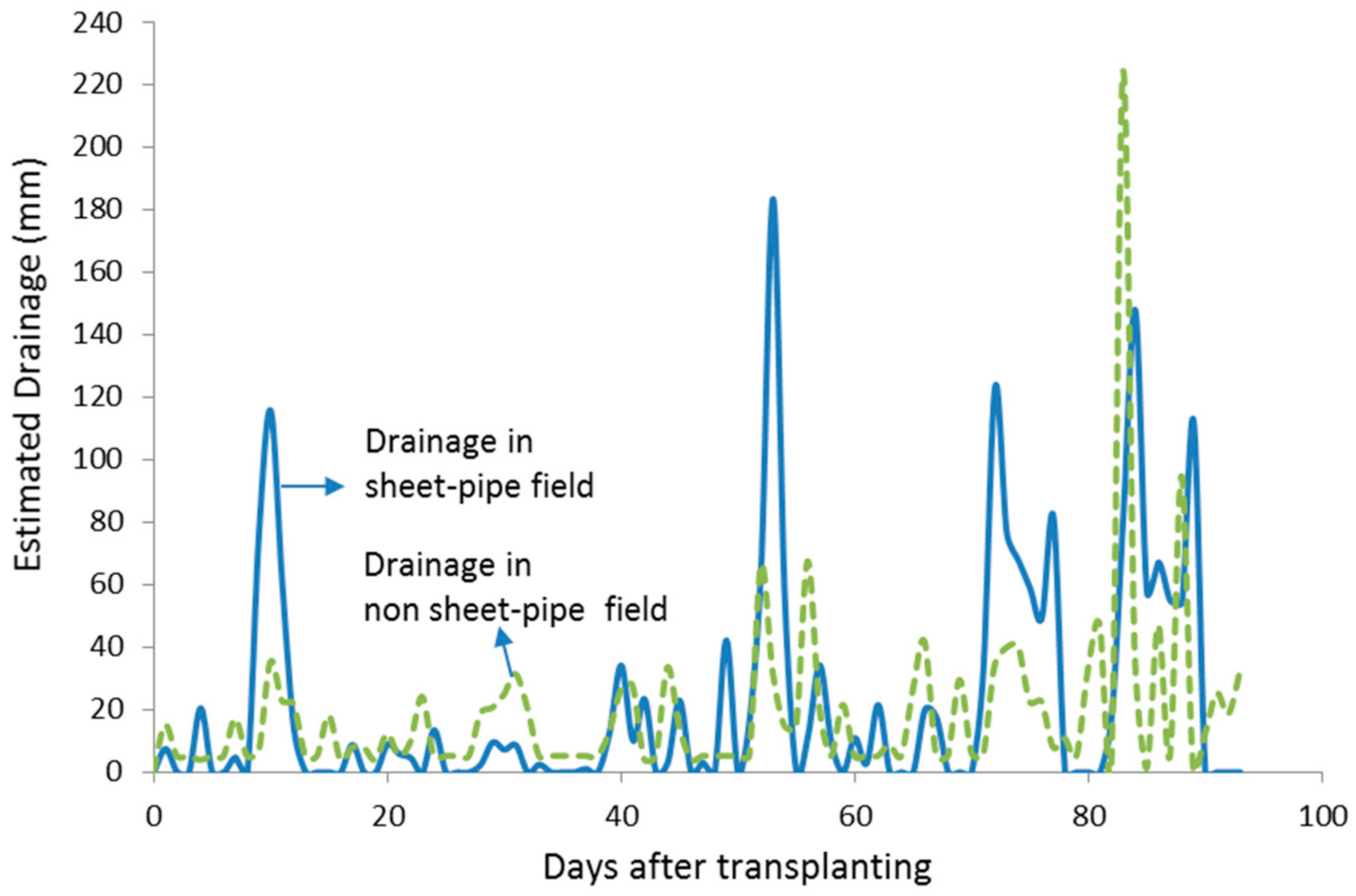
| Trait | Situ Bagendit | Inpari 6 Jete | Inpari 43 Agritan |
|---|---|---|---|
| Types | Upland and Irrigated Lowland | Irrigated Lowland | Irrigated Lowland |
| Days to harvest | 100–120 days | 118 days | 111 days |
| Plant height | 99–105 cm | 100 cm | 88 cm |
| Number of productive tillers | 23 | 17 | 22 |
| Potential Yield | 6 t/ha | 12 t/ha | 9 t/ha |
| Average yield | 4.0–5.5 t/ha | 6.8 t/ha | 7.0 t/ha |
| No | Components | SP Field | NSP Field |
|---|---|---|---|
| 1 | Rainfall (mm) | 213 | 213 |
| 2 | Irrigation (mm) | 2190 | 2214 |
| 3 | Drainage (mm) | 2061 | 1422 |
| 4 | Percolation (mm) | 171 | 377 |
| 5 | Crop Evapotranspiration (mm) | 351 | 371 |
| 6 | Average Kc | 0.97 | 1.03 |
| 7 | Error Estimation (%) | 7.48% | 10.54% |
| No | Component | SP Field | NSP Field |
|---|---|---|---|
| 1 | Grain Yield (ton/ha): | ||
| - Inpari 6 Jete | 4.82 ± 0.05 a | 4.64 ± 0.59 a | |
| - Situ Bagendit | 4.70 ± 0.41 a | 4.67 ± 0.18 a | |
| - Inpari 43 Agritan | 5.77 ± 0.20 a | 5.09 ± 0.26 b | |
| 2 | Water Productivities: | ||
| WPET (g grain/kg water) | |||
| - Inpari 6 Jete | 1.38 ± 0.01 a | 1.25 ± 0.16 a | |
| - Situ Bagendit | 1.34 ± 0.12 a | 1.26 ± 0.12 a | |
| - Inpari 43 Agritan | 1.65 ± 0.06 a | 1.37 ± 0.07 b | |
| WPI+R (g grain/kg water) | |||
| - Inpari 6 Jete | 0.20 ± 0.00 a | 0.19 ± 0.02 a | |
| - Situ Bagendit | 0.20 ± 0.02 a | 0.19 ± 0.01 a | |
| - Inpari 43 Agritan | 0.24 ± 0.01 a | 0.21 ± 0.01 b | |
| 3 | Water Use Efficiency Index | ||
| - Inpari 6 Jete | 0.22 ± 0.00 a | 0.21 ± 0.03 a | |
| - Situ Bagendit | 0.21 ± 0.02 a | 0.21 ± 0.01 a | |
| - Inpari 43 Agritan | 0.26 ± 0.01 a | 0.23 ± 0.01 b |
Publisher’s Note: MDPI stays neutral with regard to jurisdictional claims in published maps and institutional affiliations. |
© 2020 by the authors. Licensee MDPI, Basel, Switzerland. This article is an open access article distributed under the terms and conditions of the Creative Commons Attribution (CC BY) license (http://creativecommons.org/licenses/by/4.0/).
Share and Cite
Arif, C.; Setiawan, B.I.; Saptomo, S.K.; Matsuda, H.; Tamura, K.; Inoue, Y.; Hikmah, Z.M.; Nugroho, N.; Agustiani, N.; Suwarno, W.B. Performances of Sheet-Pipe Typed Subsurface Drainage on Land and Water Productivity of Paddy Fields in Indonesia. Water 2021, 13, 48. https://doi.org/10.3390/w13010048
Arif C, Setiawan BI, Saptomo SK, Matsuda H, Tamura K, Inoue Y, Hikmah ZM, Nugroho N, Agustiani N, Suwarno WB. Performances of Sheet-Pipe Typed Subsurface Drainage on Land and Water Productivity of Paddy Fields in Indonesia. Water. 2021; 13(1):48. https://doi.org/10.3390/w13010048
Chicago/Turabian StyleArif, Chusnul, Budi Indra Setiawan, Satyanto Krido Saptomo, Hiroshi Matsuda, Koremasa Tamura, Youichi Inoue, Zaqiah Mambaul Hikmah, Nurkholish Nugroho, Nurwulan Agustiani, and Willy Bayuardi Suwarno. 2021. "Performances of Sheet-Pipe Typed Subsurface Drainage on Land and Water Productivity of Paddy Fields in Indonesia" Water 13, no. 1: 48. https://doi.org/10.3390/w13010048
APA StyleArif, C., Setiawan, B. I., Saptomo, S. K., Matsuda, H., Tamura, K., Inoue, Y., Hikmah, Z. M., Nugroho, N., Agustiani, N., & Suwarno, W. B. (2021). Performances of Sheet-Pipe Typed Subsurface Drainage on Land and Water Productivity of Paddy Fields in Indonesia. Water, 13(1), 48. https://doi.org/10.3390/w13010048







